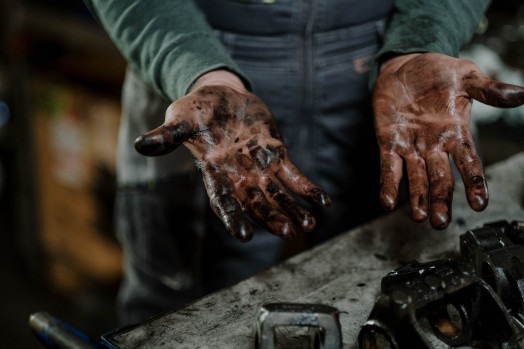Powering everything from large machinery to sophisticated equipment, hydraulic systems are essential to many industrial applications. The hydraulic fluid that is utilized is what keeps them running smoothly. The two most frequent variations are AW 46 and HLP 46. In-depth discussions of various hydraulic fluids’ unique qualities, uses, and benefits are provided in this article. Knowing the distinctions between HLP 46 and AW 46 is essential for guaranteeing the lifetime and best performance of your hydraulic systems, regardless of your level of experience as an engineer or operator.
Importance of selecting the right hydraulic fluid for optimal system performance
For diverse industrial applications, choosing the proper hydraulic fluid is essential to ensuring optimal system performance. The effectiveness, durability, and dependability of hydraulic systems are all directly impacted by the hydraulic fluid selection. Here are a few main points emphasizing the significance of this choice:
Viscosity Matching:
- Different ranges of viscosity are available for hydraulic fluids, and choosing the right viscosity is essential. To provide adequate lubrication and energy transfer, the fluid’s viscosity must meet the hydraulic system’s specifications. The incorrect viscosity can cause component damage, decreased efficiency, and increased friction.

Wear Protection:
- Frequently, hydraulic systems function with elevated pressures and loads, leading to wear and friction on their moving components. A suitable hydraulic fluid, such as one that has anti-wear qualities, forms a protective coating on metal surfaces to minimize wear and increase the longevity of vital parts like actuators, valves, and pumps.
Temperature Stability:
- The operating temperature range for hydraulic systems is broad. Across this temperature range, the hydraulic fluid of choice should retain its viscosity and lubricating qualities. Reduced fluid performance, increased wear, and degraded system efficiency can all be caused by inadequate temperature stability.
Oxidation Resistance:
- Oxidation can occur in hydraulic fluids due to their exposure to oxygen during operation. Oxidation results in sludge and varnish, which weakens the fluid and affects how well the hydraulic system works. Over time, system efficiency and purity may be preserved by selecting a hydraulic fluid with superior oxidation resistance.
Corrosion Prevention:
- Hydraulic systems are vulnerable to corrosion in damp situations. Corrosion inhibitors, which shield system components from rust and corrosion and prolong the equipment’s lifespan, are a feature of premium hydraulic fluid.
Understanding Hydraulic Fluids:
The correct operation of hydraulic systems, which are widely used in several industrial applications, depends heavily on hydraulic fluids. Ensuring the effectiveness, durability, and dependability of hydraulic equipment requires an understanding of its characteristics and uses. Here are important things to think about:
Viscosity:
- A fluid’s resistance to flow is measured by its viscosity. For effective lubrication and energy transfer in hydraulic systems, the fluid’s viscosity is essential. It makes sure the fluid lubricates and covers moving components efficiently while promoting smooth functioning.
Oxidation Stability:
- During operation, hydraulic fluids are exposed to oxygen, which causes oxidation. Sludge and varnish might build because of oxidation, which lowers the fluid’s quality. The hydraulic fluid’s capacity to withstand these negative effects and continue to function over time is determined in large part by its oxidation stability.
Anti-Wear Properties:
- High loads and pressures during hydraulic system operation frequently result in friction and component wear. Hydraulic fluids possessing anti-wear characteristics provide a shielding layer on metallic surfaces, mitigating wear and prolonging the life of vital components including pumps, valves, and cylinders.
Thermal Stability:
- When hydraulic systems are operating, heat is produced, and the hydraulic fluid needs to keep its characteristics at elevated temperatures. To avoid overheating and preserve system performance, thermal stability guarantees that the fluid can efficiently move heat away from important components.
Biodegradability:
- The use of biodegradable hydraulic fluids is becoming more important in ecologically sensitive applications. In the unlikely event of spills or leaks, biodegradable fluids are made to decompose organically over time.
HLP 46 Hydraulic Fluid:
Hydraulic fluids having a viscosity rating of ISO VG 46 include HLP 46. It is intended for use in hydraulic systems and apparatus subjected to pressures ranging from moderate to high. It is a hydraulic fluid with anti-wear additives, as indicated by the “HLP” designation, and it complies with German standard DIN 51524 Part 2 requirements.
Key characteristics and features of HLP 46 hydraulic fluid include:
- Viscosity Grade (ISO VG 46): The viscosity at 40 degrees Celsius of HLP 46 is indicated by its unique viscosity grade, ISO VG 46. With a balance between fluid flow and film strength, this viscosity falls into the range that many hydraulic systems can use.
- Anti-Wear Properties: Anti-wear chemicals in HLP 46 hydraulic fluid guard against wear and friction on hydraulic parts such actuators, valves, and pumps. This is particularly crucial for systems since high pressure can put more stress on individual parts.
- Oxidation Stability: The fluid’s resistance to oxidation aids in preventing the buildup of varnish and sludge. Consistent performance over time is ensured by good oxidation stability, which also extends the hydraulic fluid’s lifespan.
- Thermal Stability: Thermal stability refers to HLP 46’s capacity to tolerate elevated temperatures without experiencing appreciable deterioration. This characteristic is crucial for maintaining the fluid’s qualities and efficiency in transporting heat in hydraulic systems that produce heat while in use.
- Compatibility with Seals: HLP 46 is formulated with consideration for elastomer seals often used in hydraulic systems. This preserves appropriate sealing, stopping fluid leaks and guaranteeing the hydraulic system’s integrity.

AW 46 Hydraulic Fluid:
The hydraulic oil type known as AW 46 falls within the ISO VG 46 viscosity category. The label “AW” denotes “anti-wear,” signifying that this hydraulic fluid has been specially blended with additives to offer improved defense against wear and friction inside hydraulic systems. Industrial machinery, mobile equipment, and other systems that run at moderate to high pressures are among the many hydraulic applications that frequently employ AW 46.
Here are the key features and characteristics of AW 46 hydraulic fluid:
- Viscosity Grade (ISO VG 46): A unique viscosity rating, ISO VG 46, designates the viscosity of AW 46 at 40 degrees Celsius. This viscosity grade is appropriate for uses that call for a compromise between film strength and fluid flow.
- Anti-Wear Properties: The anti-wear chemicals in AW 46 hydraulic fluid are its main characteristic. By creating a protective coating on metal surfaces, these additives lessen wear and friction on vital hydraulic parts including actuators, valves, and pumps. This increases overall system dependability and helps these components last longer.
- Oxidation Stability: Because AW 46 is made to withstand oxidation, it helps keep varnish and sludge from building up in the hydraulic system. Longer fluid life is a result of the fluid’s capacity to retain its characteristics and performance over time thanks to good oxidation stability.
- Thermal Stability: For hydraulic fluids to retain their viscosity and lubricating qualities at elevated temperatures, thermal stability is essential. Hydraulic systems produce heat while they operate. Because of its thermal stability, AW 46 performs dependably across a range of operational environments.
- Seal Compatibility: Compatibility with standard hydraulic system elastomer seals is considered in the composition of AW 46. By doing so, the chance of fluid leakage is reduced, and seal degradation is prevented, guaranteeing adequate sealing.
Key Differences Between HLP 46 and AW 46:
Hydraulic fluids HLP 46 and AW 46 have comparable properties, although they could differ significantly in terms of applications, performance traits, and formulation. AW 46 and HLP 46 differ in the following important ways:
Primary Function:
- HLP 46: Hydraulic oil, lubricant, and preservation fluids, or HLP fluids, are made to effectively lubricate and protect hydraulic systems. They frequently follow certain international guidelines, such as DIN 51524 Part 2.
- AW 46: As the name implies, AW (Anti-Wear) fluids are made with additives that offer improved anti-wear protection. Their purpose is to reduce wear and friction on important parts of hydraulic systems.
Anti-Wear Additives:
- HLP 46: Anti-wear additives are occasionally added to HLP fluids, although they are not the main component of the composition. System protection and general lubrication are frequently prioritized.
- AW 46: Higher concentrations of anti-wear chemicals, which provide a protective coating on metal surfaces and lower friction and wear, are what set AW fluids apart.
Wear Protection:
- HLP 46: may not give the same amount of anti-wear qualities as specialized AW fluids, but it does provide conventional wear protection appropriate for many hydraulic applications.
- AW 46: Because it is specially designed to provide exceptional anti-wear protection, it is perfect for situations where reducing component wear is a top priority.

Oxidation Stability:
- HLP 46: intended to withstand oxidation, yet depending on the exact formulation, the stability may change.
- AW 46: has strong oxidation stability, which aids in preventing the buildup of varnish and sludge, which is crucial for preserving fluid quality over time.
Operating Conditions:
- HLP 46: appropriate for common hydraulic applications under different operating circumstances.
- AW 46: Particularly advantageous in applications where wear and increasing pressure are greater dangers.
Factors Influencing Choice:
The selection of hydraulic fluids, whether HLP 46 AW 46 or any other type, is contingent upon several criteria. These variables aid in choosing the best fluid for a certain hydraulic system. The following are important factors that affect the decision:
Operating Conditions:
- A principal factor is the hydraulic system’s operating environment. The choice of hydraulic fluid can be influenced by several factors, including exposure to pollutants, humidity, and severe temperatures. For instance, a fluid with exceptional thermal stability can be chosen if the system works under hot temperatures.
Anti-Wear Protection Needs:
- Determine the degree of wear protection that the hydraulic components need. Selecting a hydraulic fluid with improved anti-wear qualities, like AW 46, may be advantageous if the system is subjected to high pressure or large loads.
Compatibility with Seals and Materials:
- Consider if the hydraulic fluid is compatible with the materials and seals used in the hydraulic system. Leakage and degradation can be avoided by using a fluid that is compatible with elastomer seals.
Environmental Considerations:
- Biodegradability and other ecologically friendly qualities may be crucial in applications that are sensitive to the environment. In the event of spills or leaks, some hydraulic systems could need fluids with little environmental effect.
Application Specifics:
- Certain applications could have unique needs. For instance, fixed industrial gear may have different requirements than mobile hydraulic systems seen in construction equipment. Think about the requirements of the application.
Frequently asked questions:
How does HLP hydraulic oil work?
HLP hydraulic oil ensures effective operation by reducing wear and friction, lubricating, and safeguarding hydraulic system components.
Which viscosity index does HLP 46 have?
About viscosity at 40 degrees Celsius—a common measurement for hydraulic oils—HLP 46 normally falls within the ISO VG 46 viscosity category.
Is it possible to use hydraulic oil AW 46?
Indeed, AW 46 hydraulic oil provides anti-wear protection and may be used in many hydraulic systems.
How dense is the hydraulic oil HLP 46?
At 15 degrees Celsius, the density of hydraulic oil HLP 46 is approximately 0.87 grams per cubic centimeter (g/cm³).
Conclusion:
In conclusion, understanding operating conditions, system specifications, and manufacturer recommendations thoroughly is essential to choosing between AW 46 and HLP 46 hydraulic fluids. Environmental considerations, regulatory compliance, seal compatibility, anti-wear protection specifications, and seal compatibility are all significant variables. Regular fluid analysis and attention to advised maintenance protocols are necessary to maintain the best possible hydraulic system performance. A well-considered decision that considers these several factors ensures the longevity, efficiency, and reliability of hydraulic equipment.

